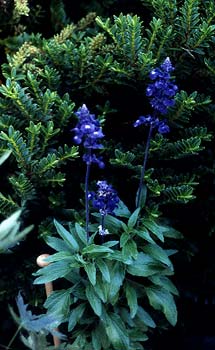
'Victoria Blue' Sage;
aka Mealy-Cup Sage;
aka Flowering Sage;
aka Blue Sage
"For me kind nature wakes her genial pow'r,
Suckles each herb, and spreads out ev'ry flow'r."
-Alexander Pope
(1688-1744)
(1688-1744)
'Victoria Blue' flowering sage is apt to be an annual in Northwest gardens, but is sometimes a tender perennial. In warmer areas than ours, it is evergreen.
The species, Salvia farinacea, is native to Texas & New Mexico, where it grows in hot exposed areas. On Puget Sound it calls for moist well-drained humousy soil & full sun exposure.
In nature, the pure wild form of Mealy Sage or Mealy-Cup Sage can reach three or four feet of height, but 'Victoria Blue' like most of this species' cultivars is a comparative dwarf which grows to only fifteen inches height.
It has bluish green leaves & the deepest deep blue flower spikes all summer long & until first frost in autumn. Although deadheading might help insure rebloom into autumn, it's equally tempting to let it go to seed on the chance it will naturalize, being otherwise apt to die out of the garden in time. I did not deadhead ours & even so it was still blooming in October.
The species name means "flour" & reinforces one of the common names, "Mealy," referring to meal flour. This is because the wild species has woolly white calyces that give the impression of a dusting of flour. This wasn't to be seen on this particular cultivar, however.
Though drought tolerant once established, it does seem to prefer moist but not boggy soil. Ours was planted in an area near Boxleaf Hebe, together with a an equally blue Delphinium grandiflorum & some other things that wanted regular watering. A typical recommendation is that it benefits from monthly liquid fertilizing to keep it blooming non-stop, though ours bloomed impressively without such attention.
It was purchased as a 99-cent on-sale tiny start, & sprang up gorgeously, paying back its investment a hundred times over. After its winter die-back at the end of 2002, I kept my fingers crossed that it might return the following year, but there are no guarantees on this one in our zone, & it did not pop up a second year. I would certainly consider planting it again in the future, though my first salvia choices tend to be those which more certainly perennialize.
See also:
Salvia farinacea 'Rhea'
Salvia farinacea 'Rhea'